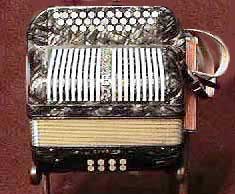 |
Hohner Club IIB
(antique)
30 keys, 2 treble reeds
Photo courtesy Wendy
Morrison
|
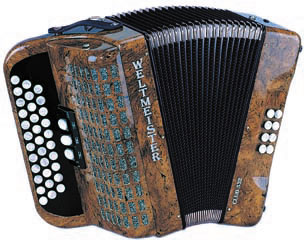
|
Weltmeister
Club 332
33 keys, 2 treble reeds
Photo courtesy Weltmeister
|
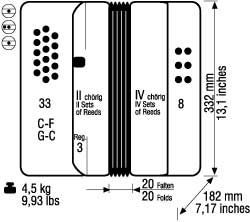
|
Specs of
Weltmeister Club 332
Illustration courtesy Weltmeister
|
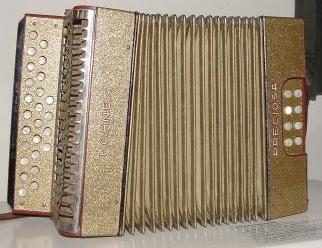
|
Hohner
Preciosa (antique)
25 keys, 2 treble reeds
Photo courtesy Alexander Rata
|
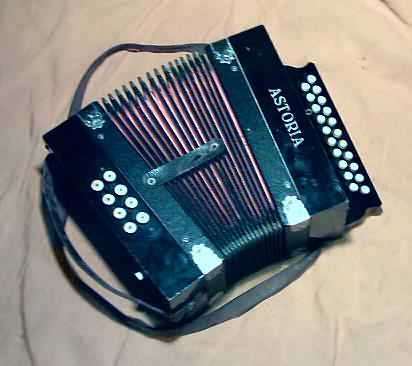
|
Astoria 2-row
(antique)
21 keys with unisonoric C on inner row
Photo courtesy Andreas
Sumerauer
|
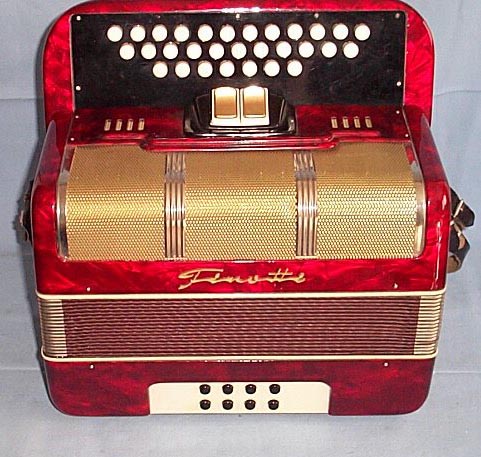
|
Finotte Club
30 key
Photo courtesy Helmut Wurzer
|
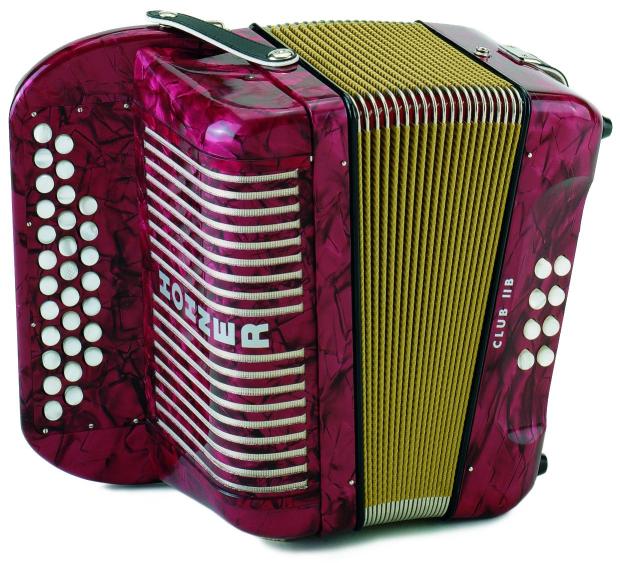
|
Hohner Club
IIB
Photo Courtesy Hohner
USA
|
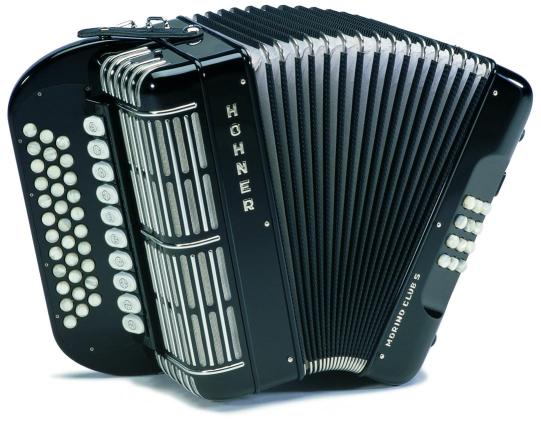
|
Hohner Morino
Club 5
Photo Courtesy Hohner
USA
|
|
Notes on illustrations:
- Instruments are not shown all according to the
same scale.
- For some models designated "antique" herein
there exist contemporary equivalents bearing the same
model name or number.
-
Most pictures are actually larger than displayed
here.
- Use your browser to view the image by itself
for greater detail.
The purpose
of this book is to introduce experienced musicians to
the Club System accordion. This book is not a graded
tutorial, nor does it teach a particular style of music.
Instead, it is an exposition of what the musician must
know to get started playing his or her own repertoire on
the Club System accordion.
It is expected that the reader already will:
- understand fundamental music theory
- know the major and minor scales
- understand the numbering of scale steps
- understand basic chord theory
Hopefully, the reader has experience playing
bellows-driven free reed instruments such as the
accordion, concertina or harmonium. For more information
on free reed instruments, please visit Jax RCFB
Free Reed Musical Instrument Page. Also, here is a
link to
Online Forum Discussion of the Club System
Accordion.
This book makes generalizations and simplifying
assumptions to facilitate the discussion. For links to
allow you to research matters further on your own, please
visit Jax RCFB
Free Reed Musical Instrument Page.
A Terminological
NoteThere is a painful ambiguity in the technical
vocabulary of button accordion. The buttons are properly
referred to as "keys". However, the term "key" is also
used to mean "musical key", as in "the key of G". The
differentiation will hopefully be clear from context.
Place of Club
System among Diatonic AccordionsThe Club System is
one of the later developments in the family of diatonic button accordions.
It is a direct descendent of the fourth-tuned two-row
button accordion, in particular the variant with a
unisonoric C in
the middle of the inner row (such as the Astoria depicted on this page), and a
sibling of the three-row International
System accordion.
The continuum of multiple-row diatonic button accordions,
excepting the Club System, is covered in a previous web
book by the same author,
A Musician's Guide to the Tex-Mex Accordion / Acordeon
Tejano / Acordeon Conjunto Norteño . The
discussion here will start from the
discussion in the previous work and proceed to a
discussion of the Club System.
Comparison of Club
System and International SystemThe 3-row
International System diatonic button accordion (the
Tex-Mex or Norteño accordion) is a generalization
of the various multiple row diatonic button accordions
prevalent in Europe. These ethnic, regional and national
variants are all based on multiple rows, each row similar
to a modern diatonic harmonica (mouth organ, "blues
harp"), which is why Hohner refers in German to diatonic
button accordion as die Handharmonika (as opposed
to die Mundharmonika , the mouth organ). The
International System truncates the multiplicity of rows
at three and adds a pair of accidentals to the press and draw of a single button at the
end of each of the three rows. This setup plays
- easily in the three different major scales
represented by the home row and its two companion rows
(and their relative minors)
- reasonably easily in two more major/minor
scales
- with increasing difficulty in other keys by
ascending and descending fourths away from the home key .
In particular, the International System allows
- the home key to be played either entirely press or
entirely draw
- the two companion keys to be played entirely draw
and nearly entirely press except for one draw
note.
The Club System takes a different sort of advantage
of the multiple row physical architecture. Rather than
expend the three rows in three essentially identical rows
pitched a fourth scale step apart, the Club System takes
the approach of a modified two-row instrument plus a
third row consisting of helper accidentals
.
As the 1957 Hohner advertisement in the frontspiece for this guide
states:
The complete CHROMATIC SCALE is made possible by a
third row of treble buttons which provide all the
sharps and flats for the first and second row. Players
of Vienna Style "push and pulls" (2 row accordion) who
feel they could improve their playing with the help of
sharp and flat keys will not find it difficult at all
to master the Club model scale as the first 2 rows of
both accordion types are almost identical.
The approach taken to right hand of the Club
System is thus somewhat similar to the approach taken by
the 30-button Anglo-Irish Concertina. The next chapter
discusses the particulars of the layout of the Club System and delves
more deeply into the compromise
represented by the Club System.
Advantages of the
Club SystemThe net tradeoff between right-hand
fingering systems of the International System and the
Tex-Mex system appears to be the following:
- Riffing harrmonically is easier on the
International System than on the Club System.
- Complex chromatic music is easier on the Club
System than on the International System.
The Club System presents some particularly
advantageous aspects:
- The modification of the two-row system results in a
slightly superior instrument when played merely as a
traditional two-row instrument.
- The Club System is entirely chromatic on the
draw within the range of the helper accidentals and
where the companion row has the
home note on the
draw.
- The range of helper accidentals depends upon
the instrument, with various models offering from
two to ten bisonoric helper keys.
- The companion row has the home note on the draw
twice (more on this in the chapter on the Club System layout ).
- The instrument has all the notes of a comparable
International System box with less repetition and more
density resulting in a wider and more complete
range.
A Philosophical
AsideThe Club System is an evolutionary step of the
diatonic accordion towards what we might call
"quasichromaticity" similar to the evolutionary step
taken by the Chemnitzer or Bandoneon over earlier Central
European concertinas. There are (at least) two paths to a
chromatic instrument.
- One is the start with an explicity chromatic system, such as
- Accordion
- Chromatic Button Accordion
- Concertina
- The other is to start from a diatonic instrument
and keep adding buttons.
- It's easy to play the basics of Diatonic
instruments.
- It is mnemonically as easy to grasp a diatonic
system with accidentals as the helpers as to grasp
a fully chromatic system.
The Anglo-Irish Concertina seems to be headed in a
similar direction. Increasingly larger models are
available with more complex helper rows. This is similar
to how the Chemnitzer Concertina and Bandoneon emerged,
starting from a core system of nine keys and expanding to
include more and more helper notes.
|
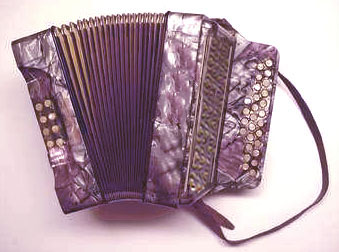 |
Hohner Victoria
Bb/Eb (antique)
27 keys, 2 treble reeds
Photo courtesy Wendy
Morrison
|
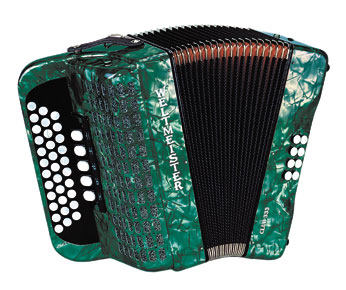
|
Weltmeister Club
333
33 keys, 3 treble reeds
Photo courtesy Weltmeister
|
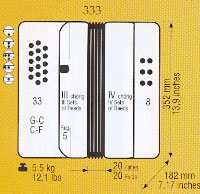
|
Specs of
Weltmeister Club 333
Illustration courtesy Weltmeister
|
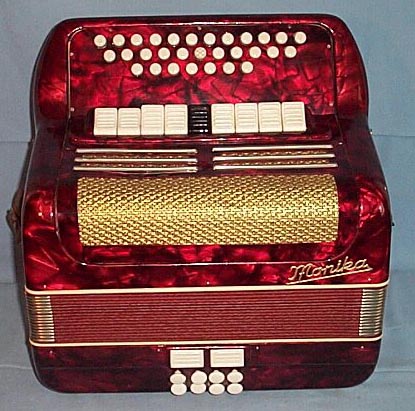
|
Monika
30 keys, 3 treble reeds
Photo courtesy Helmut Wurzer
|
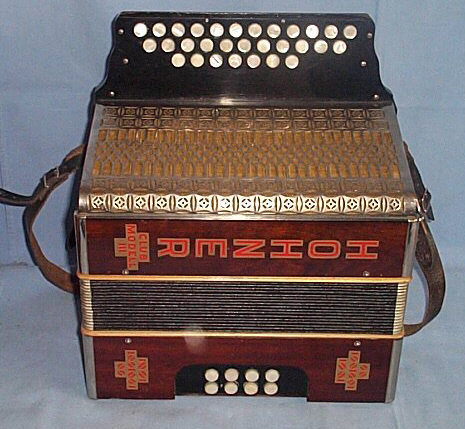
|
Hohner Club III
(antique)
30 keys, 3 treble reeds
Photo courtesy Helmut Wurzer
|
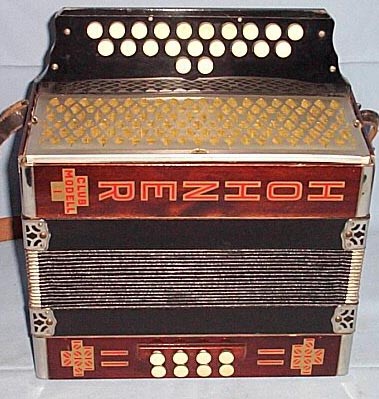 |
Hohner Club I
(antique)
21 keys, 2 treble reeds
Photo courtesy Helmut Wurzer
|
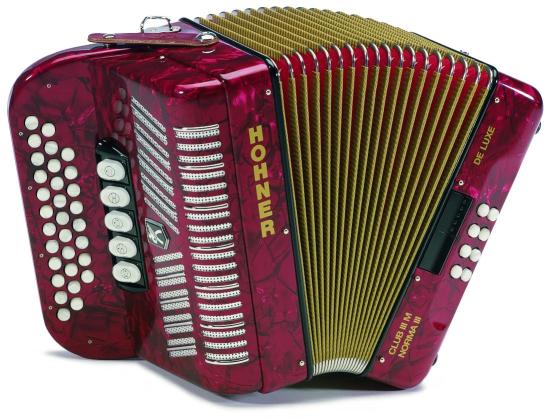
|
Hohner Norma III
(Club IIIM)
Photo Courtesy Hohner
USA
|
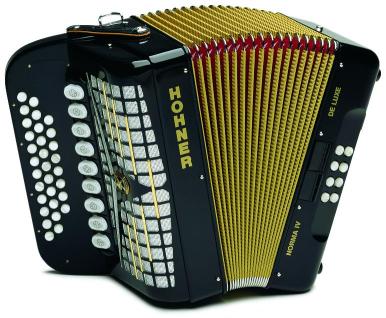
|
Hohner Norma
IV
Photo Courtesy Hohner
USA
|
|



